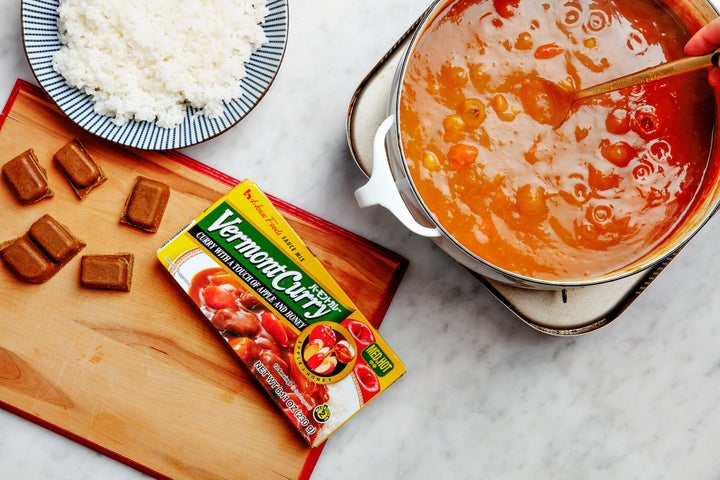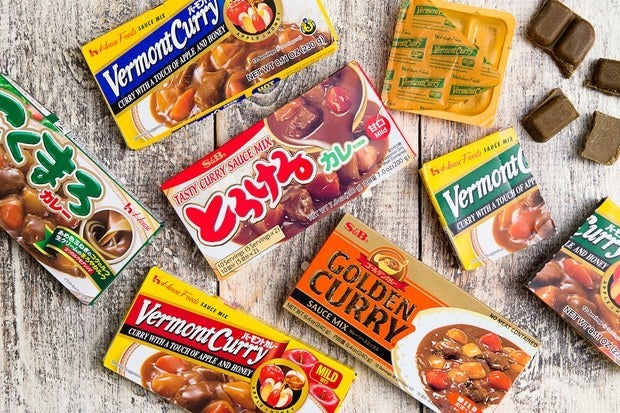For Epicurious, by Katherine Sacks.

CHELSEA KYLE, FOOD STYLING BY KATHERINE SACKS
When I traveled to Japan last October, I knew I would be eating lots of sushi. I assumed I’d have tons of sake, and I was super excited to eat anything and everything matcha flavored. What I didn’t expect to try was Japanese curry.
What’s Japanese curry, you ask? I had the same question, when a chef presented the spicy gravy over udon noodles at a supper club during one of my many epic meals in Tokyo. A few days later, I was chatting with Alisa Sanada, COO of Nagomi Visit, a Tokyo-based program that helps promote cross-cultural exchange by pairing Japanese home cooks with foreign travelers. “The easiest weeknight dinner?” she said. “Japanese-style curry is the number one thing to make.”
Easy and weeknight? My ears perked up. Back in New York, and missing Japan like no other, I was flipping through Masaharu Morimoto’s latest cookbook, Mastering the Art of Japanese Cooking (which is full of amazingly witty Morimoto musings on Japanese cooking, like his headnote for the curry recipe, BTW), when I stumbled on his recipe for Karei Raisu, or Japanese-style curry.
“Everyone grows up eating curry at home,” Morimoto explained to me via e-mail. “It’s a taste of home cooking. It’s a dish that mothers make for their children.”
The ultimate comfort food dish, Japanese-style curry is a warming one-pot meal you can toss any meat or vegetable into. And as Yuki Sugimoto, one of the Nagomi Visit hosts explained to me, it’s the kind of dish Japanese kids learn to make early on. “Since curry and rice is one of the easiest dishes to cook, my mom taught me how to make it when I was a small kid and I’ve cooked it for my family since then,” says Sugimoto. “I was already a ‘good curry chef’ at the age 10 or 11.”
If curry doesn’t sound particularly Japanese, that’s because it’s not. The Indian dish came to Japan at the end of the 19th century by way of Britain, who approximated the traditional flavors with their C&B curry powder — reportedly the world’s first manufactured curry powder. However, according to Tadashi Ono’s Japanese Soul Cooking cookbook — which devotes a whole chapter to Japanese curry — the dish didn’t really become popular in Japan until British seamen introduced it to the Japanese navy. Realizing it was a great dish to serve for a huge crew, the seamen started making giant pots of it to feed their hungry sailors. The sailors then brought their love of the dish home, and it has since become a Japanese staple of cafeterias and weeknight cooking.
Unlike the spicy Thai or Indian curries the word curry might call to mind, Japanese curry is made with a thickened broth that’s more like a gravy. It’s less spicy and more sweet, and it’s served with a variety of familiar Japanese ingredients. Many cities and regions have their own favorite curries; in Hiroshima, you’ll see it made with oysters, in Kumamoto, it’s made with horse meat, and in Hakkaido the specialty is squid ink curry.
But the thing that makes the dish a weeknight superstar? The curry roux, a packaged flavor block that’s basically like a bouillon cube on crack. Depending on the variety, curry roux can contain more than 50 ingredients — everything from cheese to banana paste to cocoa powder — to give it a combo of sweetness, spice, and rich earthiness, along with thickening ingredients and stabilizers to keep it shelf-stable (i.e. always at the ready for a weeknight dinner). Although some Japanese cooks still use curry powder instead, it’s much more common to find Japanese curry roux on pantry shelves.

Curry roux is made in endless varieties — some are more savory, some are sweeter, some more spiced — but Morimoto recommends medium-hot Vermont brand curry roux. After trying a few other brands, I agree. Vermont has a sweet note, just-the-right amount of spice, and isn’t too gummy from an overabundance of thickening ingredients. (You can find Vermont brand, among other Japanese curry roux brands, in Asian markets, international grocery stores, and online.)
Once you’ve picked a curry roux, the sky’s the limit on how you make the curry. You can cook it with whatever vegetables or meat you have on hand, but the basic method is the same: sear the meat (beef is most commonly used, but I like to keep it veggie), then add the liquid and vegetables, and boil until cooked through. Stir in the curry roux, cook a few more minutes, and you’re done! In Japan, it’s popular to start the dish by making caramelized onions. Serve the curry with udon noddles and you have a whole new dish: curry udon. Or serve it with tonkatsu, breaded pork cutlets.
Morimoto — who makes the dish at home once a week — says he likes to crack a raw egg on top and mix it in before digging into a bowl. He suggests first-timers make the recipe off the back of the box, a basic but delicious way to try out Japanese curry. For an even better version, I suggest following the Iron Chef’s recipe (below), which adds butter for richness, and is served with rice, the most classic Japanese way.
Get the recipe: Japanese-Style Curry (Karei Raisu)
More from Epicurious:
